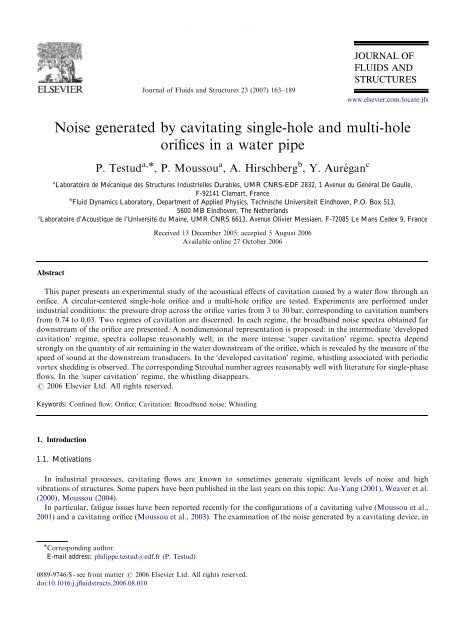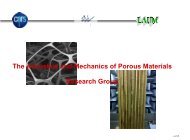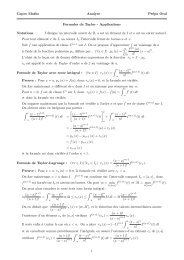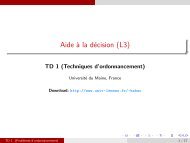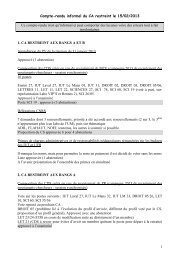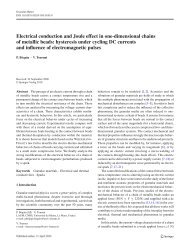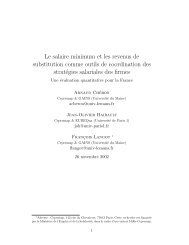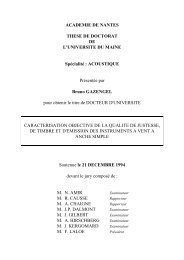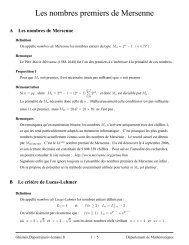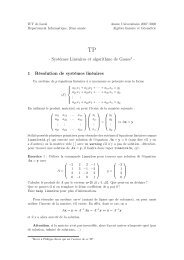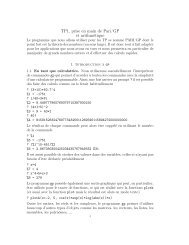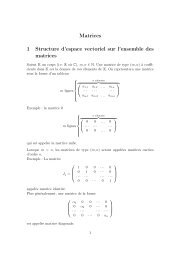Noise generated by cavitating single-hole and multi-hole orifices in ...
Noise generated by cavitating single-hole and multi-hole orifices in ...
Noise generated by cavitating single-hole and multi-hole orifices in ...
Create successful ePaper yourself
Turn your PDF publications into a flip-book with our unique Google optimized e-Paper software.
ARTICLE IN PRESSP. Testud et al. / Journal of Fluids <strong>and</strong> Structures 23 (2007) 163–189 165Fig. 1. Flow through an orifice <strong>and</strong> correspond<strong>in</strong>g evolution of the static pressure.We prefer to use the cavitation number, based on the pressure drop across the s<strong>in</strong>gularity generat<strong>in</strong>g the jet:P vs ¼ P 2DP , (3)where DP ¼ P 1 P 2 is the pressure drop across the orifice, with P 1 the static pressure upstream of the orifice <strong>and</strong> P 2 thedownstream static pressure far away from the orifice. In this choice, we follow common practice <strong>in</strong> <strong>in</strong>dustry (Tullis,1989; Franc et al., 1999; Lecoffre, 1994).One should note that both those cavitation numbers lead to very similar classifications as they are related to eachother <strong>by</strong> the pressure drop coefficient of the s<strong>in</strong>gularity.When the pressure P j has a sufficiently low value, <strong>in</strong>termittent t<strong>in</strong>y cavitation bubbles are produced <strong>in</strong> the heart of theturbulent eddies along the shear layer of the jet. This flow regime transition is called cavitation <strong>in</strong>ception, <strong>and</strong> it appearsat a cavitation number of the order of 1 (when d=D ¼ 0:30) accord<strong>in</strong>g to the data of Tullis (1989). Other references(Numachi et al., 1960; Tullis <strong>and</strong> Gov<strong>in</strong>dajaran, 1973; Ball et al., 1975; Yan <strong>and</strong> Thorpe, 1990; Kugou et al., 1996; Sato<strong>and</strong> Saito, 2001; Pan et al., 2001) are <strong>in</strong> good agreement with the values <strong>and</strong> scale effects given <strong>by</strong> Tullis (1989). Somedifferences result from the <strong>in</strong>fluence of the variation <strong>in</strong> the dissolved gas content <strong>and</strong> <strong>in</strong> the viscosity (Keller, 1994).As the jet pressure decreases further, more bubbles with larger radii are <strong>generated</strong>, form<strong>in</strong>g a white cloud. Thepressure fluctuations <strong>in</strong>crease <strong>and</strong> a characteristic shot noise can be heard. A further decrease <strong>in</strong> jet pressure <strong>in</strong>duces theformation of a large vapor pocket just downstream of the orifice, surround<strong>in</strong>g the liquid jet. The regime occurr<strong>in</strong>g afterthis transition is called super cavitation <strong>and</strong> it exhibits the largest noise <strong>and</strong> vibration levels. In the super cavitationregime, noise is known [see, for example, Van Wijngaarden (1972)], to be ma<strong>in</strong>ly <strong>generated</strong> <strong>in</strong> a shock transitionbetween the cavitation region <strong>and</strong> the pipe flow, at some distance downstream of the orifice. Downstream of the shock,some residual gas (air) bubbles can persist but pure vapor bubbles have disappeared.Cavitation <strong>in</strong>dicators are used to predict the occurrence of cavitation regimes. The use of two of them has seemedrelevant, <strong>in</strong> view of our experimental results. First, a so-called <strong>in</strong>cipient cavitation <strong>in</strong>dicator, noted s i , which predicts thetransition from a non<strong>cavitat<strong>in</strong>g</strong> flow to a moderately <strong>cavitat<strong>in</strong>g</strong> flow, that is called developed cavitation regime. Second,a so-called choked cavitation <strong>in</strong>dicator, noted s ch , which predicts the transition from a moderately <strong>cavitat<strong>in</strong>g</strong> flow to asuper <strong>cavitat<strong>in</strong>g</strong> flow, with the formation <strong>and</strong> cont<strong>in</strong>uous presence of a vapor pocket downstream of the orifice aroundthe liquid jet. To calculate both those <strong>in</strong>cipient <strong>and</strong> the choked cavitation <strong>in</strong>dicators, scal<strong>in</strong>g laws are given <strong>by</strong> Tullis(1989). They take <strong>in</strong>to account the various pressure effects <strong>and</strong> size scale effects, <strong>by</strong> means of extensive experiments on<strong>s<strong>in</strong>gle</strong>-<strong>hole</strong> <strong>orifices</strong> <strong>in</strong> water pipe flow. For <strong>multi</strong>-<strong>hole</strong> <strong>orifices</strong>, as mentioned <strong>in</strong> the same work, less data are available butidentical values are expected to hold.Only a few studies provide downstream noise spectra <strong>generated</strong> <strong>by</strong> <strong>cavitat<strong>in</strong>g</strong> <strong>orifices</strong> (Yan et al., 1988; Bistafa et al.,1989; Kim et al., 1997; Pan et al., 2001). A few complementary studies give the noise spectra created <strong>by</strong> <strong>cavitat<strong>in</strong>g</strong> valves
ARTICLE IN PRESS166P. Testud et al. / Journal of Fluids <strong>and</strong> Structures 23 (2007) 163–189(Hassis, 1999; Mart<strong>in</strong> et al., 1981). In fact, it appears that far more research has been developed on submerged water jets(Jorgensen, 1961; Esipov<strong>and</strong> Naugol’nykh, 1975; Frankl<strong>in</strong> <strong>and</strong> McMillan, 1984; Brennen, 1995; Latorre, 1997).A comprehensive overview of the state of the art <strong>in</strong> this doma<strong>in</strong> is given <strong>in</strong> Brennen (1995).2. Experimental set-up2.1. Tested <strong>orifices</strong>In the pip<strong>in</strong>g system of French nuclear power plants, a basic configuration to obta<strong>in</strong> a pressure discharge can berealized with a <strong>s<strong>in</strong>gle</strong>-<strong>hole</strong> orifice. The maximum flow velocity can reach about 10 m s 1 <strong>and</strong> the pressure drop 100 baracross the orifice. This can <strong>in</strong>duce high vibration levels. The <strong>orifices</strong> used are chosen <strong>in</strong> order to reduce the pipevibration to acceptable levels (Caillaud et al., 2006).In our study, two <strong>orifices</strong> have been tested (see Fig. 2), as follows:(i) A <strong>s<strong>in</strong>gle</strong>-<strong>hole</strong> orifice, circular, centered, with right angles <strong>and</strong> sharp edges. It has a thickness of t ¼ 14 mm ðt=d ¼0:64Þ <strong>and</strong> a diameter of d ¼ 22 mm ðd=D ¼ 0:30Þ, for a pipe diameter of D ¼ 74 mm. It is considered as a ‘th<strong>in</strong>’orifice as t=dt2 (Idel’cik, 1969). In a sharp edged orifice flow, separation occurs at the upstream <strong>in</strong>let edge. In ath<strong>in</strong> orifice, there is no reattachment of the flow with<strong>in</strong> the orifice.(ii) A <strong>multi</strong>-<strong>hole</strong> orifice, with N <strong>hole</strong>s ¼ 47 circular right-angled <strong>and</strong> sharp-edged perforations of diameter d <strong>multi</strong> ¼ 3 mm.Its total open surface is practically identical to the <strong>s<strong>in</strong>gle</strong>-<strong>hole</strong> orifice one, as it has an equivalent d eq =D ¼ 0:28 ratio.This <strong>multi</strong>-<strong>hole</strong> orifice also has the same thickness of t ¼ 14 mm ðt=d <strong>multi</strong> ¼ 4:67Þ. It behaves as a thick orificet=d\2. The flow reattaches to the wall with<strong>in</strong> the orifice.2.2. Test rigThe test-section, as shown <strong>in</strong> Fig. 3, consists out of an open loop with a hydraulically smooth steel pipe of <strong>in</strong>nerdiameter D ¼ 74 mm <strong>and</strong> wall thickness t p ¼ 8 mm. The <strong>orifices</strong> are placed between straight pipe sections with lengths,respectively, equal to 42 diameters upstream <strong>and</strong> 70 diameters downstream.The water is <strong>in</strong>jected from a tank located 17 m upstream from the orifice. The nitrogen pressure <strong>in</strong> the tank above thewater is controlled <strong>by</strong> a feedback system to ma<strong>in</strong>ta<strong>in</strong> a constant ma<strong>in</strong> flow velocity. The water is released at atmosphericpressure 20 m downstream of the orifice. The temperature is kept equal to 310 K ð1KÞ dur<strong>in</strong>g all experiments.The flow velocity U is measured 26D upstream of the orifice, <strong>and</strong> the static pressures P 1 <strong>and</strong> P 2 are determ<strong>in</strong>ed,respectively, <strong>by</strong> a transducer 11D upstream <strong>and</strong> another 40D downstream of the orifice. The fluctuat<strong>in</strong>g pressures aremonitored <strong>by</strong> means of a comb<strong>in</strong>ation of Kistler 701A piezo-electrical transducers <strong>and</strong> Kistler charge amplifiers. Thelocation of the dynamical pressure transducers is given <strong>in</strong> Fig. 4. Upstream, the transducers 1–3 are positioned, atrespectively 11D, 8D <strong>and</strong> 5D from the orifice (0.25 m between consecutive transducers). Downstream, the transducers4–10 are regularly positioned, from 7D to 39D (0.4 m between consecutive transducers).Fig. 2. Front views of the tested <strong>orifices</strong>: (a) <strong>s<strong>in</strong>gle</strong>-<strong>hole</strong> orifice; (b) <strong>multi</strong>-<strong>hole</strong> orifice.
ARTICLE IN PRESSP. Testud et al. / Journal of Fluids <strong>and</strong> Structures 23 (2007) 163–189 167Fig. 3. Scale scheme of the test rig.Fig. 4. Location of the dynamical pressure transducers upstream <strong>and</strong> downstream of the orifice.2.3. Experimental conditions2.3.1. Water qualityThe water used is tap water, dem<strong>in</strong>eralized, with pH 9 <strong>and</strong> weak conductivity. It is not degassed, hence it is expectedto be saturated with dissolved air. The volume fraction of dissolved gas (denoted <strong>by</strong> b) is high compared to othercavitation studies. This gas content has not been measured, but an estimation, assum<strong>in</strong>g saturation condition under atemperature of T ¼ 310 K or T ¼ 273 K, gives for the volume fraction an order of magnitude around, respectively, 10 2or 10 3 .It should be po<strong>in</strong>ted out that the presence of dissolved gas <strong>in</strong> the water does not mean a presence of gas bubbles <strong>in</strong> thewater. Thus, the measured upstream speed of sound does not reveal any presence of gas bubbles as it is close to the one<strong>in</strong> pure water flow.Correct<strong>in</strong>g the compressibility of the water for the <strong>in</strong>fluence of the elasticity of the pipe (diameter D ¼ 7:4 10 2 m,wall thickness e ¼ 8 10 3 m, Young’s modulus E ¼ 2 10 11 Nm 2 , Poisson ratio z ¼ 0:3), the speed of sound c th <strong>in</strong>pure water <strong>in</strong> the pipe is given <strong>in</strong> function of the speed of sound <strong>in</strong> pure water c w (Lighthill, 1978):c th ¼ c w 1 þ r w c 2 Dð1 z 2 0:5Þw. (4)eEThis predicts a speed of sound of c th ¼ 1454 m s 1 us<strong>in</strong>g c w ¼ 1523 m s 1 . The measured speed of sound upstream of theorifice is 1420 10 m s 1 .2.3.2. Experimental flow conditionsExperiments are carried out at a constant flow <strong>by</strong> controll<strong>in</strong>g the static pressure upstream of the orifice. Thedownstream pressure P 2 is imposed <strong>by</strong> the hydraulic static head of the 17.2 m high vertical pipe downstream of the
ARTICLE IN PRESS168P. Testud et al. / Journal of Fluids <strong>and</strong> Structures 23 (2007) 163–189orifice. Each experiment lasts about 90 s. Pressures <strong>and</strong> volume flows are provided <strong>in</strong> Table 1 for the six experiments onthe <strong>s<strong>in</strong>gle</strong>-<strong>hole</strong> orifice, <strong>and</strong> <strong>in</strong> Table 2 for the six experiments on the <strong>multi</strong>-<strong>hole</strong> orifice.The Reynolds number Re ¼ UD=n water based on the pipe diameter <strong>and</strong> the water viscosity varies from 2 10 5 to5 10 5 ; turbulence is fully developed, as usual <strong>in</strong> <strong>in</strong>dustrial pipes.Higher flow regimes have been tested, but the pressure transducers downstream delivered no signal, as they werelocated <strong>in</strong> a vapor pocket characteristic of the super cavitation regime. As a consequence, no acoustic data are available<strong>in</strong> these conditions, <strong>and</strong> the correspond<strong>in</strong>g hydraulic conditions are not reported <strong>in</strong> Tables 1 <strong>and</strong> 2.2.4. Dist<strong>in</strong>ction of two cavitation regimesThe application of Tullis’ formulas to our experiments gives the cavitation <strong>in</strong>dicators: s i for the developed cavitation<strong>and</strong> s ch for the super cavitation. Compared to our observations, those cavitation regime <strong>in</strong>dicators are <strong>in</strong> goodagreement:(a) For the <strong>s<strong>in</strong>gle</strong>-<strong>hole</strong> orifice: s i X0:93, s ch ¼ 0:25. The observations, based on listen<strong>in</strong>g <strong>and</strong> on the measureddownstream speed of sound, <strong>in</strong>dicate that all experiments (i.e. so0:74) are <strong>cavitat<strong>in</strong>g</strong>. Furthermore, thedownstream acoustic properties <strong>and</strong> particularly the shape of the downstream noise spectra <strong>in</strong>dicate that the lastthree experiments (i.e. so0:25) are <strong>in</strong> super cavitation regime.(b) For the <strong>multi</strong>-<strong>hole</strong> orifice: s i X0:87, s ch ¼ 0:20. The observations <strong>in</strong> this case <strong>in</strong>dicate that all experiments (i.e.so0:74) are <strong>cavitat<strong>in</strong>g</strong>. The super cavitation regime is observed for the last two experiments (i.e. so0:17).Table 1Flow conditions for the <strong>s<strong>in</strong>gle</strong>-<strong>hole</strong> orifice experiments (with st<strong>and</strong>ard deviations)Developed cavitationSuper cavitationU ðms 1 Þ 1.91 2.38 2.90 3.75 4.08 4.42St. deviation 0.06 0.04 0.04 0.03 0.03 0.05ðms 1 ÞP 1 ð10 5 PaÞ 6.3 9.2 13.3 21.4 25.0 29.5St. deviation 0.3 0.3 0.6 1.4 0.7 0.8ð10 5 PaÞP 2 ð10 5 PaÞ 2.7 2.7 2.7 2.8 2.8 2.8St. deviation 0.0 0.0 0.0 2.0 0.2 1.5ð10 5 PaÞs 0.74 0.41 0.25 0.15 0.12 0.10Table 2Flow conditions for the <strong>multi</strong>-<strong>hole</strong> orifice experiments (with st<strong>and</strong>ard deviations)Developed cavitationSuper cavitationU ðms 1 Þ 2.08 2.45 2.94 3.65 4.18 4.43St. deviation 0.02 0.04 0.04 0.02 0.02 0.04ðms 1 ÞP 1 ð10 5 PaÞ 6.5 6.9 12.9 19.8 26.0 28.3St. deviation 0.1 0.3 0.4 1.2 0.3 0.6ð10 5 PaÞP 2 ð10 5 PaÞ 2.7 2.8 2.8 2.9 3.0 0.9St. deviation 0.0 0.1 0.1 0.3 1.2 2.1ð10 5 PaÞs 0.74 0.45 0.28 0.17 0.13 0.03
2.5. Acoustic analysis methodARTICLE IN PRESSP. Testud et al. / Journal of Fluids <strong>and</strong> Structures 23 (2007) 163–189 169In the frequency range of the study, only acoustic plane waves propagate. The issue is to determ<strong>in</strong>e the spectra p þ <strong>and</strong>p represent<strong>in</strong>g, respectively, the upstream <strong>and</strong> downstream travel<strong>in</strong>g plane waves <strong>and</strong> for which Fourier-like analysisholds.From each experiment, time fluctuat<strong>in</strong>g-pressure signals are obta<strong>in</strong>ed. These data are truncated to a time <strong>in</strong>tervalwhere the acoustic properties do not evolve significantly, i.e. on a duration of about 10 s. With the help of a referencepressure p ref , we compute the cross-spectral densities G ppref ðf Þ, which are def<strong>in</strong>ed as the Fourier Transform of the timecorrelation (Bendat <strong>and</strong> Piersol, 1986). It is worth recall<strong>in</strong>g that, for a small frequency b<strong>and</strong>width Df , the mean-squarevalue of the pressure <strong>in</strong> the frequency range ½f ; f þ Df Š is given <strong>by</strong> G pp ðf Þ Df . These cross-spectra are expressed <strong>in</strong>Pa 2 =Hz. In order to get a spectral expression l<strong>in</strong>ear with the pressure, we choose to use the follow<strong>in</strong>g expression, <strong>in</strong>Pa=Hz 1=2 (see Appendix A for more details):p n ðf Þ¼G p n ðtÞp ref ðtÞðf Þpffiffiffiffiffiffiffiffiffiffiffiffiffiffiffiffiffiffiffiffiffiffiffiffiffiffið1pnp10Þ. (5)G pref ðtÞp ref ðtÞðf ÞFor upstream observations, transducer 1 is chosen as reference, <strong>and</strong> for downstream observations, transducer 10 ischosen as reference.As plane waves propagate, the acoustic pressure at one po<strong>in</strong>t is the summation of the forward (<strong>in</strong> the direction of theflow) travel<strong>in</strong>g wave p þ <strong>and</strong> of the backward travel<strong>in</strong>g wave p . We assume the speed of sound to be identical <strong>in</strong> theforward <strong>and</strong> <strong>in</strong> the backward directions, because the Mach number is low (of the order of 10 3 ). The identification ateach transducer of the local speed of sound <strong>and</strong> of the acoustic plane waves is carried out accord<strong>in</strong>g to st<strong>and</strong>ard<strong>in</strong>tensimetry techniques (Davies et al., 1980; Bode´ n <strong>and</strong> Abom, 1986; Hassis, 1999).The f<strong>in</strong>al spectra represent an average of about 20 spectra, determ<strong>in</strong>ed with a time signal of 10 s duration. Each<strong>in</strong>termediate spectrum is determ<strong>in</strong>ed with a w<strong>in</strong>dow of 1 s duration, <strong>and</strong> the successive w<strong>in</strong>dows have an overlapp<strong>in</strong>gratio of 0.5 (between 0 <strong>and</strong> 1). This average is made <strong>in</strong> order to reduce the r<strong>and</strong>om errors.The use of a <strong>s<strong>in</strong>gle</strong> reference microphone may give uncerta<strong>in</strong>ties for determ<strong>in</strong><strong>in</strong>g st<strong>and</strong><strong>in</strong>g waves if there is a pressurenode at a microphone. This happens when the reflection coefficient is close to unity. At low frequencies (below 500 Hz),this is the case for developed cavitation (see Fig. 6). However, as shown <strong>in</strong> Fig. 19, the microphones are not close to thepressure nodes of the st<strong>and</strong><strong>in</strong>g wave patterns. At higher frequencies, <strong>and</strong> for super cavitation, the reflection coefficient isso low that we do not expect a problem (see Figs. 6 <strong>and</strong> 7).2.6. Acoustic boundary conditions on both sides of the orifice2.6.1. Acoustic boundary conditions upstream of the orificeThe acoustic conditions imposed <strong>by</strong> the test rig upstream of the orifice are quite reflect<strong>in</strong>g, as illustrated <strong>in</strong> Fig. 5 <strong>by</strong>the upstream reflection coefficient R ¼ p =p þ , def<strong>in</strong>ed as the ratio between the forward <strong>and</strong> the backward propagat<strong>in</strong>gplane waves. These reflect<strong>in</strong>g characteristics are due to <strong>multi</strong>ple partial reflections of the acoustic waves on variouselements present on the upstream part of the test rig as an open valve, a few bends <strong>and</strong> section restrictions. Thoseelements have not been modified <strong>in</strong> the course of the experiments, so that these reflect<strong>in</strong>g conditions not vary muchfrom one experiment to another.2.6.2. Acoustic boundary conditions downstream of the orificeThe downstream acoustic boundary condition depends on the cavitation regime, developed cavitation regime orsuper cavitation regime.In developed cavitation regime (see Fig. 6), the downstream reflection coefficient has a magnitude close to 1 up to600 Hz, which <strong>in</strong>dicates a strong reflect<strong>in</strong>g condition. As the phase is a l<strong>in</strong>ear function of the frequency, the reflectionpo<strong>in</strong>t is determ<strong>in</strong>ed: it corresponds to the location of an open valve (at 53D downstream of the orifice). The cavity ofthis valve is hence filled with a very compressible fluid, i.e. air, impos<strong>in</strong>g an acoustic pressure node p 0 ¼ 0.The reflection coefficient shows values above unity <strong>in</strong> Figs. 5 <strong>and</strong> 6. This may be due to measurement <strong>in</strong>accuracies.Also the presence of a noise source outside the ma<strong>in</strong> source region is possible <strong>and</strong> would give values above unity.In the super cavitation regime (see Fig. 7), the downstream reflection coefficient falls down below the value of 0.5. Asa first approximation, the pipe term<strong>in</strong>ation is then almost anechoic. This difference of behavior between the developedcavitation regime <strong>and</strong> the super cavitation regime is not analysed <strong>in</strong> the framework of the present study.This variation of the downstream acoustic boundary conditions is specific of the test rig. It has some impact on thelevels of the downstream spectra. This will be taken <strong>in</strong>to account further <strong>in</strong> the study of the downstream noise spectra.
ARTICLE IN PRESS170P. Testud et al. / Journal of Fluids <strong>and</strong> Structures 23 (2007) 163–189piPhase (rad)0-pi10 500 1000 1500Amplitude1.21U=2.38 m.s -10.80.60.40.2010 500 1000 1500Frequency (Hz)Fig. 5. Typical acoustic reflection coefficient R ¼ pþpupstream of the orifice (calculated at transducer 1).It should be po<strong>in</strong>ted out that, for some frequencies, the determ<strong>in</strong>ation of the acoustical spectra is <strong>in</strong>accurate. Butcoherence values are still good enough, as illustrated <strong>in</strong> Fig 8, to allow a satisfactory fit of the spectra to determ<strong>in</strong>e thespeed of sound, as illustrated <strong>in</strong> Fig. 9.3. Cavitation regimes3.1. Hydraulic model for the pressure drop DP across the <strong>s<strong>in</strong>gle</strong>-<strong>hole</strong> orificeA simple model of the hydraulics of the <strong>s<strong>in</strong>gle</strong>-<strong>hole</strong> orifice is proposed. The hydraulic conditions (pressure <strong>and</strong> Machnumber) at the jet of the orifice are estimated, hence giv<strong>in</strong>g some <strong>in</strong>sight for a physical <strong>in</strong>terpretation of the differentcavitation regimes.This hydraulic model is a simple classical Borda-Carnot model, see, for example Durrieu et al. (2001). It assumes an<strong>in</strong>compressible stationary <strong>s<strong>in</strong>gle</strong>-phase flow, that is, no effect of cavitation on the hydraulics. Also, the ratio S j =Sbetween the free jet cross-section <strong>and</strong> the pipe cross-section S is considered as fixed.Firstly, mass conservation requiresS j U j ¼ SU. (6)Secondly, the flow upstream of the jet is assumed to be an <strong>in</strong>viscid steady potential flow, so thatP 1 þ 1 2 r wU 2 ¼ P j þ 1 2 r wU 2 j . (7)Downstream of the jet, a turbulent mix<strong>in</strong>g region is followed <strong>by</strong> a uniform flow of velocity U. Neglect<strong>in</strong>g friction at thewalls, <strong>and</strong> assum<strong>in</strong>g a th<strong>in</strong> ðt=dt2Þ orifice (with no reattachment of the flow <strong>in</strong>side the <strong>hole</strong> of the orifice), one obta<strong>in</strong>s(S d is the cross-section of the orifice)SP j þ r w U 2 j S j ¼ SP 2 þ r w U 2 S. (8)The pressure P j <strong>and</strong> the velocity U j at the jet are deduced from Eqs. (6)–(8). The measured pressure drop, denoted <strong>by</strong>DP measured , is <strong>in</strong> this case equal to the pressure drop across the orifice: DP measured ¼ P 1 P 2 . Hence, denot<strong>in</strong>g <strong>by</strong> a thecontraction coefficient ða ¼ S j =S d Þ, this developed cavitation model gives" #DP measuredð1=2Þr w U 2 ¼ S 2 1 þ 2 2 S , (9)S jS j
ARTICLE IN PRESSP. Testud et al. / Journal of Fluids <strong>and</strong> Structures 23 (2007) 163–189 171piPhase (rad)0-pi10 500 1000 1500Amplitude1.210.80.60.40.2010 500 1000 1500Frequency (Hz)U=1.91 m.s -1Fig. 6. Typical acoustic reflection coefficient R ¼ p pþdownstream of the orifice (calculated at transducer 8) <strong>in</strong> developed cavitationregime.piPhase (rad)0Amplitude-pi10 500 1000 15001.210.80.60.40.2010 500 1000 1500Frequency (Hz)U=3.75 m.s -1Fig. 7. Typical acoustic reflection coefficient R ¼ p pþdownstream of the orifice (calculated at transducer 8) <strong>in</strong> super cavitation regime.the first part represent<strong>in</strong>g the dissipation from upstream to the jet, <strong>and</strong> the second part the dissipation from the jet todownstream.F<strong>in</strong>ally, after simplifications, we f<strong>in</strong>dDP measuredð1=2Þr w U 2 ¼" # D 212 1d a. (10)
ARTICLE IN PRESS172P. Testud et al. / Journal of Fluids <strong>and</strong> Structures 23 (2007) 163–18910.90.80.7Coherence0.60.50.40.30.20.100 500 1000 1500 2000Frequency (Hz)Fig. 8. Example of the coherence function between two successive transducers (<strong>s<strong>in</strong>gle</strong>-<strong>hole</strong> orifice, U ¼ 2:38 m s 1 , between transducers7 <strong>and</strong> 8).10.8(p 6 (ω)+p 8 (ω)) / p 7 (ω)fit with c=1425 m/s0.60.4cos (ω∆l/c)0.20-0.2-0.4-0.6-0.8-10 500 1000 1500 2000Frequency (Hz)Fig. 9. Example of the determ<strong>in</strong>ation of the speed of sound us<strong>in</strong>g a fit on the spectra for three successive transducers (<strong>s<strong>in</strong>gle</strong>-<strong>hole</strong>orifice, U ¼ 2:38 m s 1 , middle transducer: 7).In super cavitation, the downstream static sensor is <strong>in</strong> the jet region, measur<strong>in</strong>g P j . The pressure drop measuredrepresents the dissipation from upstream to the jet (the first part of the preced<strong>in</strong>g expression):DP measuredð1=2Þr w U 2 ¼ 1 D 4a 2 1. (11)d
ARTICLE IN PRESSP. Testud et al. / Journal of Fluids <strong>and</strong> Structures 23 (2007) 163–189 173320300280∆P measured / (0.5ρ w U 2 )260240220200<strong>s<strong>in</strong>gle</strong>-<strong>hole</strong> experimentsth<strong>in</strong>-<strong>hole</strong> developed-cavitation model: α=0.65th<strong>in</strong>-<strong>hole</strong> super-cavitation model: α=0.651801 2 3 4 5 6 7 8U (m.s -1 )Fig. 10. Comparison between the Borda–Carnot model with different contraction coefficients a <strong>and</strong> the <strong>s<strong>in</strong>gle</strong>-<strong>hole</strong> orificemeasurements.Table 3Conditions at the jet us<strong>in</strong>g the Borda–Carnot model for the <strong>s<strong>in</strong>gle</strong>-<strong>hole</strong> orificeDeveloped cavitationSuper cavitationU ðms 1 Þ 1.91 2.38 2.90 3.75 4.08 4.42U j ðms 1 Þ 33 41 50 65 71 76c m<strong>in</strong> ðms 1 Þ 28 30 34 13 — —P j ð10 5 PaÞ 1.4 1.6 2.0 0.3 — —Fig. 10 compares the two models us<strong>in</strong>g a contraction coefficient a ¼ 0:65 with experimental results (additionalexperimental results <strong>in</strong> super cavitation, not shown <strong>in</strong> Table 1, are plotted), as follows:(i) In the developed cavitation regime ðUo3:5ms 1 Þ, theory agrees qualitatively well with experiments, predict<strong>in</strong>g DPwith<strong>in</strong> 15%.(ii) In the super cavitation regime ðU43:5ms 1 Þ, experimental data agree remarkably well with the model, predict<strong>in</strong>gDP with<strong>in</strong> 1%. Incidentally, we observe that super cavitation does not <strong>in</strong>duce a strong slope variation <strong>in</strong> the DPversus U curve. This is mentioned <strong>in</strong> Tullis (1989) for <strong>orifices</strong> of low d=D ratio (approximately under 0.5, which isthe case here).As a result, the model is validated as a satisfy<strong>in</strong>g broad estimation of the hydraulics, tak<strong>in</strong>g a contraction coefficient of 0.65.This value is reasonable, as it is close to 0.61 which is the theoretical value for sharp-edged <strong>orifices</strong> with a jet from a gas to afree space exit (Gilbarg, 1960) <strong>and</strong> it is less than 0.70, which <strong>in</strong>dicates (Blev<strong>in</strong>s, 1984) that the real radius of curvature of theupstream edge of the orifice is less than 1% of the pipe diameter (this confirms that this edge is a neat sharp angle edge).Us<strong>in</strong>g this model, the pressure <strong>and</strong> the velocity at the jet are estimated, see Table 3, as follows:(a) The pressure <strong>in</strong> the jet P j is very close to the vapor pressure of the liquid ðP v ¼ 5:65 10 3 PaÞ <strong>in</strong> super cavitationregime. This is coherent with the stationary presence of a vapor pocket <strong>in</strong> this region. Hence, it may be an <strong>in</strong>dicatorof the transition to super cavitation regime.(b) The velocity U j is compared to c m<strong>in</strong> , an evaluation of the lowest speed of sound <strong>in</strong> the two-phase region of the jet.An estimation of it can be obta<strong>in</strong>ed, see Van Wijngaarden (1972): the m<strong>in</strong>imum speed of sound is obta<strong>in</strong>ed for a
ARTICLE IN PRESSP. Testud et al. / Journal of Fluids <strong>and</strong> Structures 23 (2007) 163–189 175320300280∆P measured / (0.5ρ w U 2 )260240220200180160<strong>multi</strong>-<strong>hole</strong> experimentsthick-<strong>hole</strong> developed-cavitation model: α=0.65th<strong>in</strong>-<strong>hole</strong> developed-cavitation model: α=0.65thick-<strong>hole</strong> super-cavitation model: α=0.65<strong>s<strong>in</strong>gle</strong>-<strong>hole</strong> experiments1401 2 3 4 5 6 7 8U (m.s -1 )Fig. 11. Evaluation of the <strong>multi</strong>-<strong>hole</strong> orifice model <strong>and</strong> comparison between the <strong>s<strong>in</strong>gle</strong>-<strong>hole</strong> orifice measurements.Table 4Conditions at the jet us<strong>in</strong>g the Borda–Carnot model for the <strong>multi</strong>-<strong>hole</strong> orificeDeveloped cavitationSuper cavitationU ðms 1 Þ 2.08 2.45 2.94 3.65 4.18 4.43U j ðms 1 Þ 36 43 51 63 73 77c m<strong>in</strong> ðms 1 Þ 20 — 27 — — —P j ð10 5 PaÞ 0.7 — 1.3 — —example <strong>in</strong> Fig. 14). The higher harmonics are typical of steady whistl<strong>in</strong>g stabilized <strong>by</strong> a nonl<strong>in</strong>ear feedback effect as forall self-susta<strong>in</strong>ed oscillations (Fletcher, 1979; Rockwell <strong>and</strong> Naudascher, 1979).Scant literature has been found on whistl<strong>in</strong>g of <strong>cavitat<strong>in</strong>g</strong> <strong>orifices</strong> <strong>in</strong> pipes. A vortex shedd<strong>in</strong>g phenomenon <strong>in</strong>presence of cavitation has been <strong>in</strong>vestigated <strong>by</strong> Sato <strong>and</strong> Saito (2001), but <strong>in</strong> the particular case of thick <strong>orifices</strong>ðt=d\2Þ. On th<strong>in</strong> <strong>orifices</strong>, some visualizations (Moussou et al., 2003) made on other EDF experiments have shown thepossibility of the presence of vortex-shedd<strong>in</strong>g <strong>in</strong> cavitation regime, as can be seen <strong>in</strong> Fig. 15, from Archer et al. (2002).The whistl<strong>in</strong>g frequencies are given <strong>in</strong> Table 5. They do not <strong>in</strong>crease cont<strong>in</strong>uously with the flow velocity, as one wouldexpect for a hydrodynamic oscillation edge-tone like (Blake <strong>and</strong> Powell, 1983). The stable frequency is typical of anacoustic feedback which creates <strong>and</strong> ma<strong>in</strong>ta<strong>in</strong>s the acoustic oscillation close to a resonance frequency. This is alsorevealed <strong>by</strong> the lock<strong>in</strong>g of the phase of the time pressure signals on successive sensors, which <strong>in</strong>dicates a st<strong>and</strong><strong>in</strong>g wavepattern.Upstream of the orifice, the level of whistl<strong>in</strong>g is higher than downstream: hence the acoustic feedback is suspected tohappen predom<strong>in</strong>antly upstream. The upstream reflection coefficient, see Fig. 5, is reflect<strong>in</strong>g but irregular: no clearacoustic reflection po<strong>in</strong>t can be identified (as it can be for the cavity of a valve downstream, see Section 2.6.2). Thisirregular shape is due to the <strong>in</strong>tricacy of the upstream rig design, with a succession of elbows, slight restrictions ofsections <strong>and</strong> some open valves.It is also worth mention<strong>in</strong>g that the whistl<strong>in</strong>g frequency does not co<strong>in</strong>cide with any downstream natural acousticfrequency. This is coherent with the acoustic uncoupl<strong>in</strong>g observed from both sides of the orifice.The <strong>s<strong>in</strong>gle</strong>-<strong>hole</strong> orifice has a ratio t=d ¼ 0:6, <strong>in</strong>ferior to 2, so that it is considered as a th<strong>in</strong> orifice. We assume that thewhistl<strong>in</strong>g phenomenon is <strong>in</strong>fluenced <strong>by</strong> the thickness of the orifice t, rather than its diameter. It is also natural to use the
ARTICLE IN PRESS176P. Testud et al. / Journal of Fluids <strong>and</strong> Structures 23 (2007) 163–189Fig. 12. From other experiments at EDF (Archer et al., 2002), visualization of the developed cavitation regime for a <strong>s<strong>in</strong>gle</strong>-<strong>hole</strong> orifice(d=D ¼ 0:30, t=d ¼ 0:10, D ¼ 2:66 10 1 m) with s ¼ 0:49 <strong>and</strong> U ¼ 1:50 m s 1 (DP ¼ 3:1 10 5 Pa, P 1 ¼ 4:6 10 5 Pa). White bubbleclouds are observed around the jet formed at the orifice.Dynamical pressure signal at sensor 9 (10 5 Pa)2.521.510.50-0.5-1-1.5-2σ = 0.41-2.540 40.05 40.1 40.15Time (s)Fig. 13. Typical dynamical time pressure signal from a downstream transducer for the developed cavitation regime (here for the <strong>s<strong>in</strong>gle</strong><strong>hole</strong>orifice at s ¼ 0:41).velocity at the orifice U d as a relevant scal<strong>in</strong>g velocity. Hence the Strouhal number is def<strong>in</strong>ed asSt ¼ f 0tU d, (14)<strong>and</strong> values are reported <strong>in</strong> Table 5.
ARTICLE IN PRESSP. Testud et al. / Journal of Fluids <strong>and</strong> Structures 23 (2007) 163–189 17710 9 Frequency (Hz)10 8f 02 f 0U=1.91 m.s -1p− 2 (Pa 2 /Hz)10 710 610 510 40 200 400 600 800 1000Fig. 14. Detection of whistl<strong>in</strong>g frequency f 0 with harmonics on upstream plane wave spectra pU ¼ 1:91 m s 1 , f 0 ¼ 359 Hz <strong>and</strong> the first harmonics at 718 Hz).(here for the <strong>s<strong>in</strong>gle</strong>-<strong>hole</strong> orifice atFig. 15. From other experiments at EDF (Archer et al., 2002), visualization of a <strong>cavitat<strong>in</strong>g</strong> <strong>and</strong> whistl<strong>in</strong>g <strong>s<strong>in</strong>gle</strong>-<strong>hole</strong> orifice(d=D ¼ 0:30, t=d ¼ 0:10, D ¼ 2:6 10 1 m) with s ¼ 0:35 <strong>and</strong> U ¼ 1:97 m s 1 (DP ¼ 5:3 10 5 Pa, P 1 ¼ 7:2 10 5 Pa).The Strouhal number is obta<strong>in</strong>ed <strong>in</strong> the range 0.18–0.26. These values are close to data on <strong>orifices</strong>: Anderson (1953)f<strong>in</strong>ds a Strouhal number around 0.2 for whistl<strong>in</strong>g <strong>orifices</strong> <strong>in</strong> air with a free air exit. In Anderson’s experiments, the<strong>orifices</strong> were a bit th<strong>in</strong>ner (with 0:2pt=Dp0:5, whereas here t=D ¼ 0:19) <strong>and</strong> the Reynolds numbers smaller(U d t=n air H10 3 with n air the k<strong>in</strong>ematic viscosity of air, whereas here U d t=n water H10 5 ).The <strong>multi</strong>-<strong>hole</strong> orifice is a thick one, as t=d <strong>multi</strong> ¼ 4:7. Hence it is no surprise that it does not whistle. The flowreattaches itself <strong>in</strong>side each <strong>hole</strong>, which stabilizes the shear layers of the jet <strong>and</strong> hence prevents whistl<strong>in</strong>g <strong>in</strong> the samemanner as observed for the <strong>s<strong>in</strong>gle</strong>-<strong>hole</strong> orifice.
ARTICLE IN PRESS178P. Testud et al. / Journal of Fluids <strong>and</strong> Structures 23 (2007) 163–189Table 5Strouhal number St ¼ f 0 t=U d of the whistl<strong>in</strong>g frequency f 0 (only observed <strong>in</strong> the <strong>s<strong>in</strong>gle</strong>-<strong>hole</strong> orifice case)U ðms 1 Þ 1.91 1.91 2.38 2.38 2.90 2.90c ðms 1 Þ 1390 1200 660 1420 1130 1420f 0 (Hz) 359 397 421 436 427 434St 0.23 0.26 0.22 0.23 0.18 0.19Fig. 16. From other experiments at EDF, visualization of the super cavitation regime for a <strong>s<strong>in</strong>gle</strong>-<strong>hole</strong> orifice.3.5. Super cavitation visualization <strong>and</strong> typical temporal signalIn the super cavitation regime, a vapor pocket is created <strong>in</strong> the jet region, as illustrated <strong>in</strong> Fig. 16.When the vapor pocket exp<strong>and</strong>s <strong>and</strong> reaches the downstream transducers, those transducers no longer deliver anyacoustical signal. This constitues an evidence for the existence of the vapor pocket.It appears that the length of the vapor pocket <strong>in</strong>creases quickly with flow velocity. The length of the vapor pocket<strong>in</strong>creases from about 7D at U 0 ¼ 3:8ms 1 to 18D at U 0 ¼ 4:4ms 1 <strong>and</strong> is larger than 38D at U 0 ¼ 4:7ms 1 for the<strong>s<strong>in</strong>gle</strong>-<strong>hole</strong> orifice. For the <strong>multi</strong>-<strong>hole</strong> orifice, the length of the vapor pocket <strong>in</strong>creases from around 7D at U 0 ¼ 4:2ms 1to larger than 38D at U 0 ¼ 4:5ms 1 .The typical time-fluctuat<strong>in</strong>g pressure signals obta<strong>in</strong>ed are very different from those <strong>in</strong> the developed cavitation regime(see Fig. 17). They are asymmetric around the mean pressure, exhibit<strong>in</strong>g very large positive spikes, up to 20 bar, l<strong>in</strong>kedto the collapse of bubbles.Focus<strong>in</strong>g on time signals (see an illustration <strong>in</strong> Fig. 18), it is seen that the phenomenon of bubble implosion ischaracterized first <strong>by</strong> a decrease <strong>in</strong> negative values of the fluctuat<strong>in</strong>g pressure with a characteristic duration of a tens ofmilliseconds, followed <strong>by</strong> an abrupt <strong>in</strong>crease of the pressure, a ‘spike’, with a characteristic duration of 1 ms. Bymodel<strong>in</strong>g this bubble volume evolution with a monopole source, which is a common <strong>and</strong> satisfactory simple model; see,for <strong>in</strong>stance, Brennen (1995), the first decrease is l<strong>in</strong>ked with a decrease of the bubble size from its <strong>in</strong>itial size to a valueclose to zero; the second part of the signal is l<strong>in</strong>ked with a pressure shock wave orig<strong>in</strong>at<strong>in</strong>g from the abrupt collision ofthe water particles. However, extremely high amplitudes are observed <strong>in</strong> comparison to Brennen (1995) (cf. Fig 3.19).This can be due either to the large size of our bubbles or to the effect of conf<strong>in</strong>ement.
ARTICLE IN PRESSP. Testud et al. / Journal of Fluids <strong>and</strong> Structures 23 (2007) 163–189 179Dynamical pressure signal at sensor 9 (10 5 Pa)20151050σ = 0.10-540 40.05 40.1 40.15Time (s)Fig. 17. Spurious pressure pulses (spikes) from collaps<strong>in</strong>g bubbles on dynamical time pressure signal from a downstream transducer <strong>in</strong>super cavitation regime (here for the <strong>s<strong>in</strong>gle</strong>-<strong>hole</strong> orifice at s ¼ 0:10).2015Fluctuat<strong>in</strong>g pressure (x10 5 Pa)1050-547.07 47.075 47.08 47.085 47.09 47.095 47.1Time (s)Fig. 18. Cavitation peak <strong>in</strong> super cavitation regime (<strong>s<strong>in</strong>gle</strong>-<strong>hole</strong> orifice at s ¼ 0:10).4. Results <strong>in</strong> the developed cavitation regimeThe <strong>s<strong>in</strong>gle</strong>-<strong>hole</strong> <strong>and</strong> the <strong>multi</strong>-<strong>hole</strong> orifice developed cavitation regimes are presented together, as they show similaracoustical behavior. Firstly, results on the acoustic features of this cavitation regime are <strong>in</strong>troduced: the observedvariations of the downstream speed of sound <strong>and</strong> the presence of resonance frequencies <strong>in</strong> downstream spectra. Thenthe downstream spectra, depend<strong>in</strong>g on those acoustical features, are presented <strong>and</strong> discussed.
ARTICLE IN PRESS180P. Testud et al. / Journal of Fluids <strong>and</strong> Structures 23 (2007) 163–1894.1. Acoustic features4.1.1. Spontaneous variations of the downstream speed of soundFor a fixed set of hydraulic conditions <strong>in</strong> the developed cavitation regime, the downstream speed of sound mayspontaneously evolve. For <strong>in</strong>stance, the <strong>s<strong>in</strong>gle</strong>-<strong>hole</strong> orifice experiment at U ¼ 2:38 m s 1 shows the downstream speed ofsound evolv<strong>in</strong>g from 660 m s 1 (dur<strong>in</strong>g the first 20 s) to 1420 m s 1 (till the end of the experiment: 90 s).This variation of the speed of sound <strong>in</strong>dicates that air bubbles are present, <strong>in</strong> vary<strong>in</strong>g quantity, <strong>in</strong> the water fardownstream of the orifice. For <strong>in</strong>stance, a value of 660 m s 1 <strong>in</strong>dicates a volume gas fraction <strong>in</strong> the water between 10 3<strong>and</strong> 10 4 , assum<strong>in</strong>g the static pressure be<strong>in</strong>g between P j <strong>and</strong> P 2 [we use a classic formula; see, for example, VanWijngaarden (1972)]. On the contrary, a value of 1420 m s 1 <strong>in</strong>dicates a negligible content of air <strong>in</strong> the water, as it isclose to the speed of sound <strong>in</strong> pure water [which equals to 1454 m s 1 , as presented <strong>in</strong> Section 2.3.1].Cavitation bubbles, when they are formed, are orig<strong>in</strong>ally ma<strong>in</strong>ly constituted of vapor. Dur<strong>in</strong>g their lifetime, they aregradually filled with air, due to the diffusion of the dissolved gas present <strong>in</strong> the water surround<strong>in</strong>g them. As they driftdownstream, mov<strong>in</strong>g away from their region of creation, they reach regions where the pressure recovers higher levels.Pure vapor bubbles cannot persist, those bubbles rema<strong>in</strong><strong>in</strong>g far downstream of the orifice are ma<strong>in</strong>ly filled with air (seefor example Fig. 12). Consequently, the observed variation of the quantity of air bubbles is suspected to be due to an<strong>in</strong>homogeneity of the dissolved gas content <strong>in</strong> the <strong>in</strong>jected water. This <strong>in</strong>homogeneity may be related to temperaturevariations <strong>in</strong> the experimental <strong>in</strong>stallations. This hypothesis is all the more plausible as the water used has not receivedany degass<strong>in</strong>g treatment, hence hav<strong>in</strong>g a fluctuat<strong>in</strong>g <strong>and</strong> high dissolved gas content, not measured but estimated around10 2 or 10 3 (values at saturation conditions for T ¼ 273 <strong>and</strong> 310 K, respectively). In some experiments, the change <strong>in</strong>residual air bubble content occurs after the water from the pipe segment between the orifice <strong>and</strong> the tank has beenevacuated <strong>and</strong> ‘fresh’ tank water has started to flow through the orifice.These variations of the downstream speed of sound dur<strong>in</strong>g each experiment have some <strong>in</strong>fluence on the acousticalbehavior downstream of the orifice: the values of the natural frequencies, appear<strong>in</strong>g downstream, are alteredproportionally with the speed of sound.The propagat<strong>in</strong>g waves are subjected to two-phase flow damp<strong>in</strong>g, as already mentioned <strong>by</strong> Hassis (1999). As regards thislast effect, no significant variation of the propagat<strong>in</strong>g wave amplitude could be measured along the downstream sensors,but the downstream acoustical reflection coefficient appears to vary significantly with the downstream speed of sound.4.1.2. Acoustical uncoupl<strong>in</strong>g from both sides of the orificeAn acoustical uncoupl<strong>in</strong>g is observed between acoustical spectra upstream <strong>and</strong> downstream of the orifice: the naturalfrequencies present downstream are strongly attenuated on upstream spectra; the whistl<strong>in</strong>g, when present, is visible onupstream spectra, but hardly on downstream spectra; <strong>and</strong>, furthermore, the background noise on downstream spectra is higherthan the one on upstream spectra, approximately from a factor 2 (for U ¼ 1:91 m s 1 ) up to 7 (for U ¼ 2:90 m s 1 )forthe<strong>s<strong>in</strong>gle</strong>-<strong>hole</strong> orifice, <strong>and</strong> much more significantly for the <strong>multi</strong>-<strong>hole</strong> orifice, with an approximately constant factor of about 10.This acoustical uncoupl<strong>in</strong>g is an effect of cavitation as there is chok<strong>in</strong>g (<strong>in</strong>dicated <strong>in</strong> Table 3).4.1.3. Presence of natural modes downstreamIn this developed cavitation regime, resonance frequencies are systematically observed <strong>in</strong> acoustical spectradownstream of the orifice (both for the <strong>s<strong>in</strong>gle</strong>-<strong>hole</strong> <strong>and</strong> the <strong>multi</strong>-<strong>hole</strong>).The acoustic boundary conditions are of a similar type, as the frequencies are of the form: f n ¼ nf 1 , f 1 be<strong>in</strong>g the firstresonance frequency. More precisely, these acoustic boundary conditions can be identified <strong>by</strong> extrapolat<strong>in</strong>g the st<strong>and</strong><strong>in</strong>gwave patterns at those resonance frequencies. This extrapolation is made possible as a series of transducers (7 <strong>in</strong>number) is present downstream of the orifice. As a result, we f<strong>in</strong>d two acoustic pressure nodes p 0 ¼ 0 (see Fig. 19),discussed above, as follows:(i) One acoustic pressure node is found far downstream of the orifice, at 52D ð1DÞ. It is the result of the <strong>in</strong>fluence of acavity of an open valve filled with air. The reflection coefficient imposed <strong>by</strong> such a cavity has been presented <strong>in</strong>Fig. 6. The magnitude of the reflection coefficient jRj is close to 1, which confirms the acoustic <strong>in</strong>fluence of this cavity.(ii) Another is found just downstream of the orifice, at 4D ð1DÞ. It is likely to be caused <strong>by</strong> a cavitation cloud.4.2. <strong>Noise</strong> spectra <strong>generated</strong> downstream<strong>Noise</strong> spectra <strong>generated</strong> <strong>in</strong> the pipe downstream of the orifice for the developed cavitation regime are presented <strong>in</strong> thissection.
ARTICLE IN PRESSP. Testud et al. / Journal of Fluids <strong>and</strong> Structures 23 (2007) 163–189 181Real part of the cross-spectra (Pa/Hz 0.5 )1.510.50-0.5-1x 10 4p’~0p’~0-1.5-1 0 1 2 3 4 5↑ Orifice↑ Downstream valveDistance (m)Fig. 19. In the developed cavitation regime, two acoustic boundary conditions p 0 ’ 0 are found downstream of the orifice, hencenatural frequencies appear, po<strong>in</strong>ted out <strong>by</strong> the <strong>in</strong>terpolation of the values of the cross-spectra at those first natural frequencies (here forthe <strong>s<strong>in</strong>gle</strong>-<strong>hole</strong> orifice at U ¼ 2:38 m s 1 , c ¼ 1420 m s 1 <strong>and</strong> five natural frequencies: 188 Hz, m 386 Hz, . 574 Hz, ’ 770 Hz,E 957 Hz).The downstream transducers give a far-field measurement, as they are not located <strong>in</strong> the source region ma<strong>in</strong>lyconstituted of bubble implosions located just downstream of the orifice. The acoustical power measured at downstreamtransducers represents the noise <strong>generated</strong> <strong>in</strong> the pipe. Under the assumptions of plane-wave propagation <strong>and</strong> no<strong>in</strong>fluence of the flow (the Mach number is around 10 3 ), the acoustical power takes the expression: Sðp þ2 p 2 Þ=ðr w c w Þ(Morfey, 1971).It is furthermore assumed that the backward propagat<strong>in</strong>g wave spectrum of p is small enough to be neglected. Evenif acoustical reflection is observed to occur downstream, this estimation of the source of noise is considered satisfactoryenough as an order of magnitude (this is all the more relevant as logarithmic representation is used). Thus, it comes tothe source power be<strong>in</strong>g represented <strong>by</strong> the quantity Sp þ2 =ðr w c w Þ.Of course, this representation is no more valid for the discrete frequencies which are whistl<strong>in</strong>g harmonics <strong>and</strong>resonance frequencies, as the backward propagat<strong>in</strong>g wave has great <strong>in</strong>fluence <strong>in</strong> those cases.The acoustical power spectra obta<strong>in</strong>ed downstream of the orifice for the developed cavitation regime are given <strong>in</strong>Fig. 20 for the <strong>s<strong>in</strong>gle</strong>-<strong>hole</strong> orifice <strong>and</strong> <strong>in</strong> Fig. 21 for the <strong>multi</strong>-<strong>hole</strong> orifice. The rejection frequency correspond<strong>in</strong>g to awavelength of half of the distance between two successive transducers <strong>and</strong> depend<strong>in</strong>g on the measured speed of soundhas been excluded from those results. The follow<strong>in</strong>g observations are made on those spectra:(a) spectra exhibit a hump form <strong>in</strong> the upper frequency range (above 200 Hz); this hump form is typical of cavitationalnoise (Mart<strong>in</strong> et al., 1981; Brennen, 1995);(b) the <strong>s<strong>in</strong>gle</strong>-<strong>hole</strong> orifice generates remarkably much more noise (<strong>by</strong> a factor of about 10 2 <strong>in</strong> the acoustical power) thanthe <strong>multi</strong>-<strong>hole</strong> orifice.4.3. Nondimensional analysis <strong>and</strong> representation4.3.1. Choice of the scal<strong>in</strong>g variables for the noise spectraScal<strong>in</strong>g is proposed <strong>in</strong> order to obta<strong>in</strong> a dimensionless representation of the acoustical source power.Cavitation noise from the implosions of bubbles is assumed to be predom<strong>in</strong>ant <strong>in</strong> order to scale the noise spectra.Hence, broadb<strong>and</strong> turbulence noise from the mix<strong>in</strong>g region downstream, whistl<strong>in</strong>g <strong>and</strong> resonance frequencies are not
ARTICLE IN PRESS182P. Testud et al. / Journal of Fluids <strong>and</strong> Structures 23 (2007) 163–18910 0 f (<strong>in</strong> Hz)10 -1S p +2 /(ρ w c) (<strong>in</strong> W/Hz)10 -210 -310 -410 -510 -6σ=0.74, c=1280 m/sσ=0.41, c=660 m/sσ=0.25, c=1430 m/s10 1 10 2 10 3Fig. 20. Acoustical power spectra <strong>in</strong> developed cavitation (<strong>s<strong>in</strong>gle</strong>-<strong>hole</strong> orifice).10 -1 f (<strong>in</strong> Hz)10 -2p+ 2 S/(ρ c) (<strong>in</strong> W/Hz)10 -310 -410 -510 -610 -7σ=0.74, c=1420 m/sσ=0.45, c=1420 m/sσ=0.28, c=1425 m/sσ=0.17, c=1425 m/s10 1 10 2 10 3Fig. 21. Acoustical power spectra <strong>in</strong> developed cavitation (<strong>multi</strong>-<strong>hole</strong> orifice).taken <strong>in</strong>to account to choose the scal<strong>in</strong>g variables. This assumption of predom<strong>in</strong>ance of cavitation noise is globallyvalid, but seems to fail at low frequencies (<strong>in</strong> this work, below 200–300 Hz approximately). Also, it is assumed thatwhistl<strong>in</strong>g does not alter cavitation noise, generaliz<strong>in</strong>g the hypothesis that broadb<strong>and</strong> noise is not affected <strong>by</strong> whistl<strong>in</strong>g[as shown <strong>in</strong> Verge (1995) for a flue organ pipe].Follow<strong>in</strong>g Blake (1986), the amplitude of noise produced <strong>by</strong> cavitation should be made dimensionless <strong>by</strong> divid<strong>in</strong>gwith the downstream pressure, <strong>and</strong> not the pressure drop, when us<strong>in</strong>g a Rayleigh–Plesset bubble dynamic model for aspherical isolated free bubble. However, r<strong>in</strong>g vortices <strong>generated</strong> <strong>by</strong> an orifice are not isolated bubbles <strong>in</strong> free space, so
ARTICLE IN PRESSP. Testud et al. / Journal of Fluids <strong>and</strong> Structures 23 (2007) 163–189 183Fig. 22. Choice of the variables d <strong>and</strong> U d for the scal<strong>in</strong>g of the noise spectra <strong>in</strong> the developed cavitation regime for the <strong>s<strong>in</strong>gle</strong>-<strong>hole</strong>orifice.that this scal<strong>in</strong>g should not hold <strong>in</strong> the case of the present study, as it also does not for sheet cavitation on airfoils(Keller, 1994).As we lack a precise model, the scal<strong>in</strong>g data are chosen for the sake of simplicity: the basic idea, as shown <strong>in</strong> Fig. 22,relies on the fact that, <strong>in</strong> the developed cavitation regime, the bubbles are created <strong>in</strong> the mix<strong>in</strong>g high-shear region of thejet.For the <strong>s<strong>in</strong>gle</strong>-<strong>hole</strong> orifice experiments, the velocity U d <strong>and</strong> the orifice diameter d are representative of the conditions<strong>in</strong> this region, hence those quantities are used <strong>in</strong> order to scale the noise spectra <strong>in</strong> this regime. Furthermore, the scal<strong>in</strong>gpressure is def<strong>in</strong>ed as the pressure drop DP across the orifice, which is a measure of the k<strong>in</strong>etic energy density <strong>in</strong> the jet.Hence for the <strong>s<strong>in</strong>gle</strong>-<strong>hole</strong> orifice <strong>in</strong> developed cavitation, fd=U d is the nondimensional frequency <strong>and</strong> p þ2 U d =ðDP 2 dÞ isthe nondimensional magnitude.For the <strong>multi</strong>-<strong>hole</strong> orifice experiments, we assume the noise issu<strong>in</strong>g from <strong>in</strong>coherent N <strong>hole</strong>s sources.Each source represents the radiation of one <strong>hole</strong>. It radiates on a characteristic surface of S=N <strong>hole</strong>s . The strength ofeach source is assumed to be <strong>in</strong>dependent of the environment of the source. This assumption is natural, as we havepreviously supposed (see previous section) that the noise <strong>generated</strong> <strong>by</strong> the <strong>s<strong>in</strong>gle</strong>-<strong>hole</strong> orifice does not depend on thediameter of the pipe. However, it should be po<strong>in</strong>ted out that this assumption is wrong when whistl<strong>in</strong>g occurs.In this model, the total acoustic power P measured downstream is a summation of the acoustic power P each sourceemitted <strong>by</strong> each source [the key element is that sources are supposed to be <strong>in</strong>coherent between each other, see Pierce(1981)]:P ¼ N <strong>hole</strong>s P each source . (15)The acoustic power of each source P each source is, <strong>by</strong> def<strong>in</strong>ition, the total acoustic <strong>in</strong>tensity flux I <strong>multi</strong>plied the surface ofthis source:P each source ¼ IS=N <strong>hole</strong>s . (16)Hence the total acoustic power isP ¼ SI. (17)The total acoustic power is consequently <strong>in</strong>dependent of the number of <strong>hole</strong>s. As previously, we ignore any downstreamreflections, so that I ¼ p þ2 =ðrcÞ.This argumentation based on energy considerations can also be conducted <strong>in</strong> terms of forces: if the source isrepresented as a force act<strong>in</strong>g on the orifice, tak<strong>in</strong>g the form Sp þ , the total force imposed on the <strong>multi</strong>-<strong>hole</strong> orifice is dueto the contribution of the forces imposed <strong>by</strong> N <strong>hole</strong>s equivalent <strong>s<strong>in</strong>gle</strong>-<strong>hole</strong> <strong>orifices</strong> with open surface S=N <strong>hole</strong>s . Thoseforces are supposed to be uncorrelated with each other. Thus, the total force squared equals N <strong>hole</strong>s times the forcesquared due to one <strong>hole</strong>. As the force squared of one <strong>hole</strong> is ðp þ S=N <strong>hole</strong>s Þ 2 , the total force squared is expressed as:N <strong>hole</strong>s ðp þ S=N <strong>hole</strong>s Þ 2 , or <strong>by</strong> simplify<strong>in</strong>g: ðp þ SÞ 2 =N <strong>hole</strong>s .The scal<strong>in</strong>g of the acoustic power is based on each source of surface S=N <strong>hole</strong>s . The scal<strong>in</strong>g velocity is the velocity atthe orifice, which is taken equal to the velocity of the <strong>s<strong>in</strong>gle</strong>-<strong>hole</strong> orifice U d , as the open surface of the two <strong>orifices</strong> arevery similar, <strong>and</strong> the scal<strong>in</strong>g length is the diameter of one <strong>hole</strong> d <strong>multi</strong> . In conclusion for the <strong>multi</strong>-<strong>hole</strong> orifice <strong>in</strong>developed cavitation: fd <strong>multi</strong> =U d is the nondimensional frequency, <strong>and</strong> p þ2 U d =ðDP 2 d <strong>multi</strong> Þ is the nondimensionalmagnitude.4.3.2. Nondimensional noise spectra <strong>generated</strong> downstreamThe dimensionless acoustical power spectra obta<strong>in</strong>ed downstream of the orifice for the developed cavitation regimeare given <strong>in</strong> Fig. 23 for the <strong>s<strong>in</strong>gle</strong>-<strong>hole</strong> orifice <strong>and</strong> <strong>in</strong> Fig. 24 for the <strong>multi</strong>-<strong>hole</strong> orifice. The follow<strong>in</strong>g observations areworth not<strong>in</strong>g.
ARTICLE IN PRESS184P. Testud et al. / Journal of Fluids <strong>and</strong> Structures 23 (2007) 163–18910 0 f d/U d (10
ARTICLE IN PRESSP. Testud et al. / Journal of Fluids <strong>and</strong> Structures 23 (2007) 163–189 185(b) The different scal<strong>in</strong>g used for the <strong>s<strong>in</strong>gle</strong>-<strong>hole</strong> <strong>and</strong> the <strong>multi</strong>-<strong>hole</strong> orifice is rather efficient as it makes the levels of thetwo types of <strong>orifices</strong> closer to each other. However, the nondimensional level of noise of the <strong>s<strong>in</strong>gle</strong>-<strong>hole</strong> orifice is stillhigher, with a ratio of 10, than the one of the <strong>multi</strong>-<strong>hole</strong> orifice experiments; see Figs. 23 <strong>and</strong> 24.(c) We compare the cavitation noise with a st<strong>and</strong>ard turbulence noise from a non<strong>cavitat<strong>in</strong>g</strong> orifice <strong>in</strong> the low frequencyrange. Indeed, <strong>in</strong> this range of frequency, the level of noise is expected to be ma<strong>in</strong>ly determ<strong>in</strong>ed <strong>by</strong> turbulence noise(Mart<strong>in</strong> et al., 1981). We use a nondimensional turbulence noise level proposed <strong>by</strong> Moussou (2005). In this model,the scal<strong>in</strong>g is based on empirical data obta<strong>in</strong>ed with simple s<strong>in</strong>gularities (<strong>s<strong>in</strong>gle</strong>-<strong>hole</strong> orifice, valve) <strong>in</strong> water-pipeflow: the level of noise is assumed to depend only on a Strouhal number based on the pipe diameter <strong>and</strong> thepipe flow velocity. We apply this model with the values of the pipe diameter D <strong>and</strong> a pipe flow velocity of 2:20 m s 1<strong>and</strong> compare it to the <strong>s<strong>in</strong>gle</strong>-<strong>hole</strong> orifice nondimensional noise, see Fig. 23. As expected, the turbulence levelfits rather well the cavitation noise at low frequencies, with a good estimation of the slope; the cavitation noise ismuch stronger than the turbulence noise above the low-frequency range, which is a well-known result Brennen(1995).5. Results <strong>in</strong> the super cavitation regime5.1. Acoustic featuresThe super cavitation experiments exhibit two ma<strong>in</strong> differences compared to the developed cavitation experiments, asfollows:(i) The downstream speed of sound appears to be quite constant dur<strong>in</strong>g each experiment.(ii) No resonance frequencies are found on downstream spectra. The downstream reflection coefficient is much lowerthan <strong>in</strong> the developed cavitation case (as previously shown <strong>in</strong> Fig. 7). In this case, the cavity of the downstreamvalve does not reflect the acoustic waves.As for the developed cavitation case, strong acoustic uncoupl<strong>in</strong>g is observed from both sides of the orifice. The effectis much more obvious here, with an average ratio between downstream <strong>and</strong> upstream power spectra of about 2–30 forthe <strong>s<strong>in</strong>gle</strong>-<strong>hole</strong> orifice case, <strong>and</strong> about 10–50 for the <strong>multi</strong>-<strong>hole</strong> orifice case.5.2. <strong>Noise</strong> spectra <strong>generated</strong> downstream<strong>Noise</strong> spectra obta<strong>in</strong>ed downstream are given <strong>in</strong> Fig. 25 for the <strong>s<strong>in</strong>gle</strong>-<strong>hole</strong> orifice <strong>and</strong> <strong>in</strong> Fig. 26 for the <strong>multi</strong>-<strong>hole</strong>orifice (as previously, the rejection frequencies be<strong>in</strong>g excluded). We note the follow<strong>in</strong>g po<strong>in</strong>ts:(i) The typical cavitational hump form is observed, as <strong>in</strong> the developed cavitation case, but with much more evidence.The level of the hump is higher than for the developed cavitation regime; also, the frequency peak is smaller: thosetendencies when the cavitation number <strong>in</strong>creases confirm literature data Brennen (1995).(ii) Also, as <strong>in</strong> the developed cavitation case, the <strong>s<strong>in</strong>gle</strong>-<strong>hole</strong> orifice is clearly more noisy (with an approximate factor of10 on acoustical power spectra) than the <strong>multi</strong>-<strong>hole</strong> orifice.An important result is illustrated <strong>in</strong> Figs. 26 <strong>and</strong> 27: the part of the spectra succeed<strong>in</strong>g the hump peak frequencydepend strongly on the downstream speed of sound. Two-phase flow attenuations phenomena are supposed to be thecause of this observation.6. ConclusionA <strong>s<strong>in</strong>gle</strong>-<strong>hole</strong> <strong>and</strong> a <strong>multi</strong>-<strong>hole</strong> <strong>cavitat<strong>in</strong>g</strong> orifice <strong>in</strong> a water pipe have been studied experimentally under <strong>in</strong>dustrialconditions, i.e. with a pressure drop vary<strong>in</strong>g from 3 to 30 bar <strong>and</strong> a cavitation number <strong>in</strong> the range 0:03psp0:74.In the regime of developed cavitation, whistl<strong>in</strong>g is observed for the <strong>s<strong>in</strong>gle</strong>-<strong>hole</strong> orifice. This occurs at a Strouhalnumber based on the orifice thickness with a value close to 0.2.Our results <strong>in</strong>dicate that <strong>in</strong> the developed cavitation regime, a <strong>multi</strong>-<strong>hole</strong> orifice is much more silent than a <strong>s<strong>in</strong>gle</strong>-<strong>hole</strong>orifice with the same total cross-sectional open<strong>in</strong>g. This might be partially expla<strong>in</strong>ed <strong>by</strong> the absence of correlation
ARTICLE IN PRESS186P. Testud et al. / Journal of Fluids <strong>and</strong> Structures 23 (2007) 163–189between the sound produced <strong>by</strong> different <strong>hole</strong>s <strong>in</strong> the absence of whistl<strong>in</strong>g. No such difference is found <strong>in</strong> supercavitation. This is expla<strong>in</strong>ed <strong>by</strong> the fact that, <strong>in</strong> the super cavitation regime, sound is produced far downstream of theorifice rather than <strong>in</strong> a near region downstream of the orifice.A nondimensional noise source is proposed for the developed cavitation regime (cf. Section 4.3). The source modelseems satisfactory for the developed cavitation case.The results presented are certa<strong>in</strong>ly limited <strong>and</strong> call for further research. In particular, it could be <strong>in</strong>terest<strong>in</strong>g to varythe shape of the <strong>orifices</strong> <strong>and</strong> repeat the experiments with degassed water.10 1 f (<strong>in</strong> Hz)10 0p+ 2 S/ (ρ c) (<strong>in</strong> W/Hz)10 -110 -210 -310 -4σ=0.15, c=280 m/sσ=0.15, c=1420 m/sσ=0.12, c=120 m/sσ=0.12, c=1310 m/sσ=0.10, c=1230 m/sσ=0.10, c=340 m/s10 1 10 2 10 3Fig. 25. Acoustical power spectra <strong>in</strong> super cavitation (<strong>s<strong>in</strong>gle</strong>-<strong>hole</strong> orifice).10 1 f (<strong>in</strong> Hz)10 0p+ 2 S/ (ρ c) (<strong>in</strong> W/Hz)10 -110 -210 -310 -4σ=0.03, c=1400 m/sσ=0.13, c=1010 m/sσ=0.13, c=700 m/s10 1 10 2 10 3Fig. 26. Acoustical power spectra <strong>in</strong> super cavitation (<strong>multi</strong>-<strong>hole</strong> orifice).
ARTICLE IN PRESSP. Testud et al. / Journal of Fluids <strong>and</strong> Structures 23 (2007) 163–189 18710 1 f (<strong>in</strong> Hz)10 0p+ 2 S/ (ρ c) (<strong>in</strong> W/Hz)10 -110 -210 -310 -4σ=0.15, c=1420 m/sσ=0.15, c=1300 m/sσ=0.15, c=610 m/sσ=0.15, c=280 m/s10 1 10 2 10 3Fig. 27. Super cavitation (<strong>s<strong>in</strong>gle</strong>-<strong>hole</strong> orifice): <strong>in</strong>fluence of the speed of sound on the noise spectra.AcknowledgmentThe experiments have been designed <strong>and</strong> realized <strong>by</strong> MM. S. Caillaud, Ch. Mart<strong>in</strong> <strong>and</strong> L. Paulhiac.Appendix A. Acoustic analysisWe assume that only plane waves propagate <strong>in</strong> the pipe. First, cross-spectral density functions G ppref are used. They arewell suited to acoustic analysis, because they elim<strong>in</strong>ate nonpropagat<strong>in</strong>g noise present <strong>in</strong> time measurements. Indeed, if wedecompose time pressure measurements pðtÞ <strong>in</strong>to a nonpropagat<strong>in</strong>g signal p nonprop ðtÞ <strong>and</strong> a propagat<strong>in</strong>g one, we havepðtÞ¼p þ ðtÞþp ðtÞþp nonprop ðtÞ.(A.1)Hav<strong>in</strong>g def<strong>in</strong>ed <strong>and</strong> fixed a reference sensor <strong>and</strong> apply<strong>in</strong>g the cross-spectral density functions, we get an expression where thenonpropagat<strong>in</strong>g pressure is removed because it is not correlated to the propagat<strong>in</strong>g pressure:G pðtÞpref ðtÞðoÞ¼G p þ ðtÞp ref ðtÞðoÞþG p ðtÞpref ðtÞðoÞ.(A.2)pSecond, we def<strong>in</strong>e quantities G ppref =ffiffiffiffiffiffiffiffiffiffiffiffiffi G pref p refwhich can be h<strong>and</strong>led like Fourier Transforms, <strong>and</strong> which are almost<strong>in</strong>dependent of the reference pressure. Indeed, if we assume a perfect coherence between the po<strong>in</strong>t of observation <strong>and</strong> thereference sensor, we havejG ppref j 2¼ 1. (A.3)G pp G pref p refpIn this case the quantity G ppref =ffiffiffiffiffiffiffiffiffiffiffiffiffi G pref p refdoes not depend on the reference sensor. In practice, the reference sensor is takenclosest to the po<strong>in</strong>ts of observation.F<strong>in</strong>ally, we calculate plane waves. Consider<strong>in</strong>g two consecutive sensors, denoted n <strong>and</strong> n þ 1, plane wavespropagation <strong>and</strong> the l<strong>in</strong>earity characteristics of the cross-spectral density function giveG p þnþ1 p ref ðoÞ ¼G p þ n p refðoÞe jot ,G pnþ1 p refðoÞ ¼G pn p refðoÞe þjot ,(A.4)(A.5)
188ARTICLE IN PRESSP. Testud et al. / Journal of Fluids <strong>and</strong> Structures 23 (2007) 163–189pwith t be<strong>in</strong>g the time of flight of the wave between the two sensors. For the sake of ease, we note p n for G pn p ref=ffiffiffiffiffiffiffiffiffiffiffiffiffiffi G pref p ref.By means of Eqs. (A.2), (A.4) <strong>and</strong> (A.5), we get the plane wave spectra:p þ n ðoÞ ¼p nðoÞ e þjot þ p nþ1 ðoÞ, (A.6)2j s<strong>in</strong>ðotÞp n ðoÞ ¼ p nðoÞ e jot þ p nþ1 ðoÞ, (A.7)2j s<strong>in</strong>ðotÞfor p upstream measurements ð1pnp2Þ <strong>and</strong> downstream measurements ð4pnp9Þ. These spectra are expressed <strong>in</strong>Pa=ffiffiffiffiffiffiHz .The reflection coefficient is def<strong>in</strong>ed as p =pþ downstream of the orifice, <strong>and</strong> <strong>by</strong> p þ =p upstream, because weassume the source of sound to be located <strong>in</strong> the region of the orifice. For example, if a zero pressure condition is locatedfar downstream of the orifice, <strong>and</strong> if T is the time of flight toward this pressure node, the reflection coefficient at thiscurrent po<strong>in</strong>t is e 2joT .ReferencesAnderson, A.B.C., 1953. A circular-orifice number describ<strong>in</strong>g dependency of primary Pfeifenton frequency on differential pressure, gasdensity <strong>and</strong> orifice geometry. Journal of the Acoustical Society of America 25, 626–631.Archer, A., Boyer, A., Nimanbeg, N., L’Exact, C., Lemercier, S., 2002. Re´ sultats des essais hydrauliques et hydroacoustiques du tronconPTR 900 sur la boucle EPOCA (<strong>in</strong> French). EDF R&D, Technical Note HI-85/02/023/A, France.Au-Yang, M.K., 2001. Flow-Induced Vibration of Power <strong>and</strong> Process Plant Components: A Practical Workbook. ASME Press, NewYork.Ball, J.W., Tullis, J.P., Stripl<strong>in</strong>g, T., 1975. Predict<strong>in</strong>g cavitation <strong>in</strong> sudden enlargements. ASCE Journal of the Hydraulics Division 101,857–870.Bendat, J.S., Piersol, A.G., 1986. R<strong>and</strong>om Data—Analysis <strong>and</strong> Measurement Procedures, second ed. Wiley-Interscience, New York,ISBN 0-471-04000-2.Bistafa, S.R., Lauchle, G.C., Reethof, G., 1989. <strong>Noise</strong> <strong>generated</strong> <strong>by</strong> cavitation orifice plates. ASME Journal of Fluids Eng<strong>in</strong>eer<strong>in</strong>g 111,278–289.Blake, W.K., 1986. Mechanics of Flow-Induced Sound <strong>and</strong> Vibration, vol. II. Academic Press, Orl<strong>and</strong>o.Blake, W.K., Powell, A., 1983. The development of contemporary views of flow-tone generation. In: Recent Advances <strong>in</strong>Aeroacoustics, Spr<strong>in</strong>ger, New York.Blev<strong>in</strong>s, R., 1984. Applied Fluid Dynamics H<strong>and</strong>book. Krieger, New York ISBN 0-89464-717-2.Bodén, H., Abom, M., 1986. Influence of errors on the two-microphone method for acoustic properties <strong>in</strong> ducts. Journal of theAcoustical Society of America 79 (2).Brennen, C.E., 1995. Cavitation <strong>and</strong> Bubble Dynamics. Oxford University Press, Oxford.Caillaud, S., Gibert, J.R., Moussou, P., Cohen, J., Millet, F., 2006. Effect on pipe vibrations of cavitation <strong>in</strong> an orifice <strong>and</strong> <strong>in</strong> globestylevalves. In: ASME Pressure Vessels <strong>and</strong> Pip<strong>in</strong>g Division Conference, Proceed<strong>in</strong>gs PVP2006-ICPVT11-93882, Vancouver,Canada.Davies, P.O.A.L., Bhattacharva, M., Bento Coelho, J.L., 1980. Measurement of plane wave acoustic fields <strong>in</strong> flow ducts. Journal ofSound <strong>and</strong> Vibration 72, 539–542.Durrieu, P., Hofmans, G., Ajello, G., Boot, R., Aurégan, Y., Hirschberg, A., Peters, M.C.A.M., 2001. Quasisteady aero-acousticresponse of <strong>orifices</strong>. Journal of the Acoustical Society of America 110 (4), 1859–1872.Esipov, I.B., Naugol’nykh, K.A., 1975. Cavitation noise <strong>in</strong> submerged jets. Soviet Physics Acoustics 21, 404–405.Fletcher, N.H., 1979. Excitation mechanisms <strong>in</strong> woodw<strong>in</strong>d <strong>and</strong> brass <strong>in</strong>struments. Acustica 43, 63–72.Franc, J.P., Avellan, F., Belahadji, B., Billard, J.Y., Brianc-on-Marjollet, L., Fréchou, D., Fruman, D.H., Karimi, A., Kueny, J.L.,Michel, J.M., 1999. La cavitation (<strong>in</strong> French). ISBN 2.7061.0605.0, Presses Universitaires de Grenoble.Frankl<strong>in</strong>, R.E., McMillan, J., 1984. <strong>Noise</strong> generation <strong>in</strong> <strong>cavitat<strong>in</strong>g</strong> flows, the submerged jet. ASME Journal of Fluids Eng<strong>in</strong>eer<strong>in</strong>g 106,336–341.Gilbarg, G., 1960. Jets <strong>and</strong> cavities. In: Pflu¨ gge, S. (Ed.), H<strong>and</strong>buch der Physik, vol. 9. Spr<strong>in</strong>ger, Berl<strong>in</strong>, pp. 311–445.Hassis, H., 1999. <strong>Noise</strong> caused <strong>by</strong> <strong>cavitat<strong>in</strong>g</strong> butterfly <strong>and</strong> monovar valves. Journal of Sound <strong>and</strong> Vibration 225, 515–526.Idel’cik, I.E., 1969. Memento des pertes de charge (<strong>in</strong> French). Eyrolles, Paris.Jorgensen, D.W., 1961. <strong>Noise</strong> from <strong>cavitat<strong>in</strong>g</strong> submerged water jets. Journal of the Acoustical Society of America 33 (10), 1334–1338.Keller, A.P., 1994. New scal<strong>in</strong>g laws for hydrodynamic cavitation <strong>in</strong>ception. In: Second International Symposium On Cavitation,vol. 2, Tokyo, Japan, pp. 327–334.Kim, B.C., Pak, B.C., Cho, C.H., Chi, D.S., Choi, H.M., Choi, Y.M., Park, K.A., 1997. Effects of cavitation <strong>and</strong> plate thickness onsmall diameter ratio orifice meters. Flow Measurement <strong>and</strong> Instrumentation 8, 85–92.
ARTICLE IN PRESSP. Testud et al. / Journal of Fluids <strong>and</strong> Structures 23 (2007) 163–189 189Kugou, N., Matsuda, H., Izuchi, H., Miyamoto, H., Yamazaki, A., Ogasawara, M., 1996. Cavitation characteristics of restriction<strong>orifices</strong>. ASME Fluids Eng<strong>in</strong>eer<strong>in</strong>g Division Conference, FED-vol. 236 (1), San Diego, California, pp. 457–462.Latorre, R., 1997. Bubble cavitation noise <strong>and</strong> the cavitation noise spectrum. Acta Acustica 83, 424–429.Lecoffre, Y., 1994. La cavitation, traqueurs de bulles (<strong>in</strong> French). Hermes, Paris, ISBN 2-86601-409-X.Lighthill, J., 1978. Waves <strong>in</strong> Fluids. Cambridge University Press, Cambridge.Mart<strong>in</strong>, C.S., Medlarz, H., Wiggert, D.C., Brennen, C.E., 1981. Cavitation <strong>in</strong>ception <strong>in</strong> spool valves. ASME Journal of FluidsEng<strong>in</strong>eer<strong>in</strong>g 103, 564–576.Morfey, C.L., 1971. Acoustic energy <strong>in</strong> non-uniform flows. Journal of Sound <strong>and</strong> Vibration 14, 159–170.Moussou, P., 2005. An attempt to scale the vibration of water pipes. Proceed<strong>in</strong>gs 71217 of PVP, ASME, Denver, Colorado, USA.Moussou, P., Caillaud, L., Villouvier, V., Archer, A., Boyer, A., Rechu, B., Benazet, S., 2003. Vortex-shedd<strong>in</strong>g of a <strong>multi</strong>-<strong>hole</strong> <strong>orifices</strong>ynchronized to an acoustic cavity <strong>in</strong> a PWR pip<strong>in</strong>g system. In: PVP-vol. 465, Flow-Induced Vibration PVP2003-2086, ASMEPress, New York, pp. 161–168.Moussou, P., Cambier, C., Lachene, D., Longar<strong>in</strong>i, S., Paulhiac, L., Villouvier, V., 2001. Vibration <strong>in</strong>vestigation of a French PWRpower plant pip<strong>in</strong>g system caused <strong>by</strong> <strong>cavitat<strong>in</strong>g</strong> butterfly valves. In: PVP-vol. 420–2, Flow-Induced Vibration: Axial Flow, Pip<strong>in</strong>gSystems, Other Topics, ASME Press, New York, pp. 99–106.Moussou, P., Lafon, Ph., Potapov, S., Paulhiac, L., Tijssel<strong>in</strong>g, A., 2004. Industrial cases of FSI due to <strong>in</strong>ternal flows. In: N<strong>in</strong>thInternational Conference on Pressure Surges, Chester (UK), vol. 1. pp. 167–184, BHR Group Limited.Numachi, F., Yamabe, M., Oba, R., 1960. Cavitation effect on the discharge coefficient of the sharp-edged orifice plate. ASMEJournal of Basic Eng<strong>in</strong>eer<strong>in</strong>g 82, 1–11.Pan, S.S., Xiang, T., Wu, B., 2001. Investigat<strong>in</strong>g to cavitation behavior of orifice tunnel. CAV2001, Fourth Symposium on Cavitation,California Institute of Technology, Pasadena, USA hhttp://cav2001.library.caltech.edu/222i.Pierce, A.D., 1981. Acoustics: An Introduction to its Physical Pr<strong>in</strong>ciples <strong>and</strong> Applications. McGraw-Hill Book Company Inc.,New York.Rockwell, D., Naudascher, E., 1979. Self-susta<strong>in</strong>ed oscillations of imp<strong>in</strong>g<strong>in</strong>g free shear layers. Annual Review of Fluid Mechanics 11,67–94.Sato, K., Saito, Y., 2001. Unstable cavitation behavior <strong>in</strong> a circular–cyl<strong>in</strong>drical orifice flow. CAV2001, Fourth Symposium onCavitation, California Institute of Technology, Pasadena, USA hhttp://cav2001.library.caltech.edu/318i.Tullis, J.P., 1989. Hydraulics of Pipel<strong>in</strong>es: Pumps, Valves, Cavitation, Transients. Wiley Interscience Ed., New York.Tullis, J.P., Gov<strong>in</strong>dajaran, R., 1973. Cavitation <strong>and</strong> size scale effects for <strong>orifices</strong>. ASCE Journal of the Hydraulics Division 99,417–430.Van Wijngaarden, L., 1972. One-dimensional flow of liquids conta<strong>in</strong><strong>in</strong>g small gas bubbles. Journal of Fluid Mechanics 16, 369–396.Verge, M.P., 1995. Aeroacoustics of conf<strong>in</strong>ed jets. Thesis, Technische Universiteit E<strong>in</strong>dhoven, The Netherl<strong>and</strong>s, ISBN-90-386-0306-1.Weaver, D.S., Ziada, S., Au-Yang, M.K., Chen, S.S., Padoussis, M.P., Petitgrew, M.J., 2000. Flow-<strong>in</strong>duced vibration of power <strong>and</strong>process plant components: progress <strong>and</strong> prospects. ASME Journal of Pressure Vessel Technology 122, 339–348.Yan, Y., Thorpe, R.B., 1990. Flow regime transitions due to cavitation <strong>in</strong> the flow through an orifice. International Journal ofMultiphase Flow 16 (6), 1023–1045.Yan, Y., Thorpe, R.B., P<strong>and</strong>it, A.B., 1988. Cavitation noise <strong>and</strong> its suppression <strong>by</strong> air <strong>in</strong> orifice flow. In: Symposium on Flow-Induced<strong>Noise</strong>, Chicago, Ill., vol. 6. ASME, New York, pp. 25–39.Young, F.R., 1999. Cavitation. Imperial College Press, London ISBN 1-86094-198-2.


